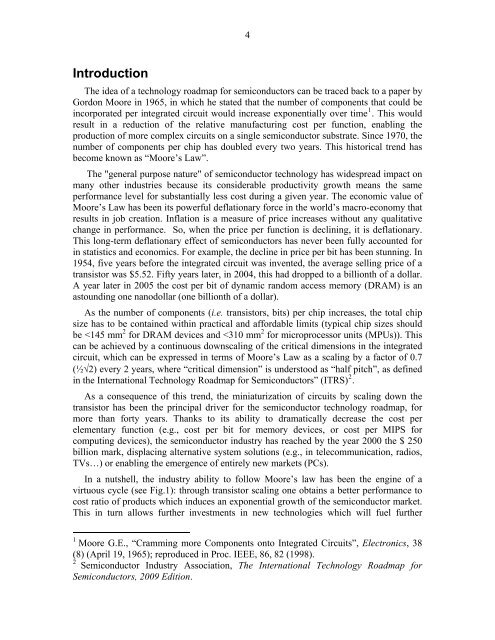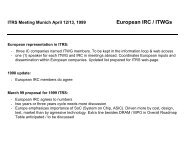More than Moore White Paper - ITRS
More than Moore White Paper - ITRS
More than Moore White Paper - ITRS
Create successful ePaper yourself
Turn your PDF publications into a flip-book with our unique Google optimized e-Paper software.
Introduction<br />
4<br />
The idea of a technology roadmap for semiconductors can be traced back to a paper by<br />
Gordon <strong>Moore</strong> in 1965, in which he stated that the number of components that could be<br />
incorporated per integrated circuit would increase exponentially over time 1 . This would<br />
result in a reduction of the relative manufacturing cost per function, enabling the<br />
production of more complex circuits on a single semiconductor substrate. Since 1970, the<br />
number of components per chip has doubled every two years. This historical trend has<br />
become known as “<strong>Moore</strong>’s Law”.<br />
The "general purpose nature" of semiconductor technology has widespread impact on<br />
many other industries because its considerable productivity growth means the same<br />
performance level for substantially less cost during a given year. The economic value of<br />
<strong>Moore</strong>’s Law has been its powerful deflationary force in the world’s macro-economy that<br />
results in job creation. Inflation is a measure of price increases without any qualitative<br />
change in performance. So, when the price per function is declining, it is deflationary.<br />
This long-term deflationary effect of semiconductors has never been fully accounted for<br />
in statistics and economics. For example, the decline in price per bit has been stunning. In<br />
1954, five years before the integrated circuit was invented, the average selling price of a<br />
transistor was $5.52. Fifty years later, in 2004, this had dropped to a billionth of a dollar.<br />
A year later in 2005 the cost per bit of dynamic random access memory (DRAM) is an<br />
astounding one nanodollar (one billionth of a dollar).<br />
As the number of components (i.e. transistors, bits) per chip increases, the total chip<br />
size has to be contained within practical and affordable limits (typical chip sizes should<br />
be




